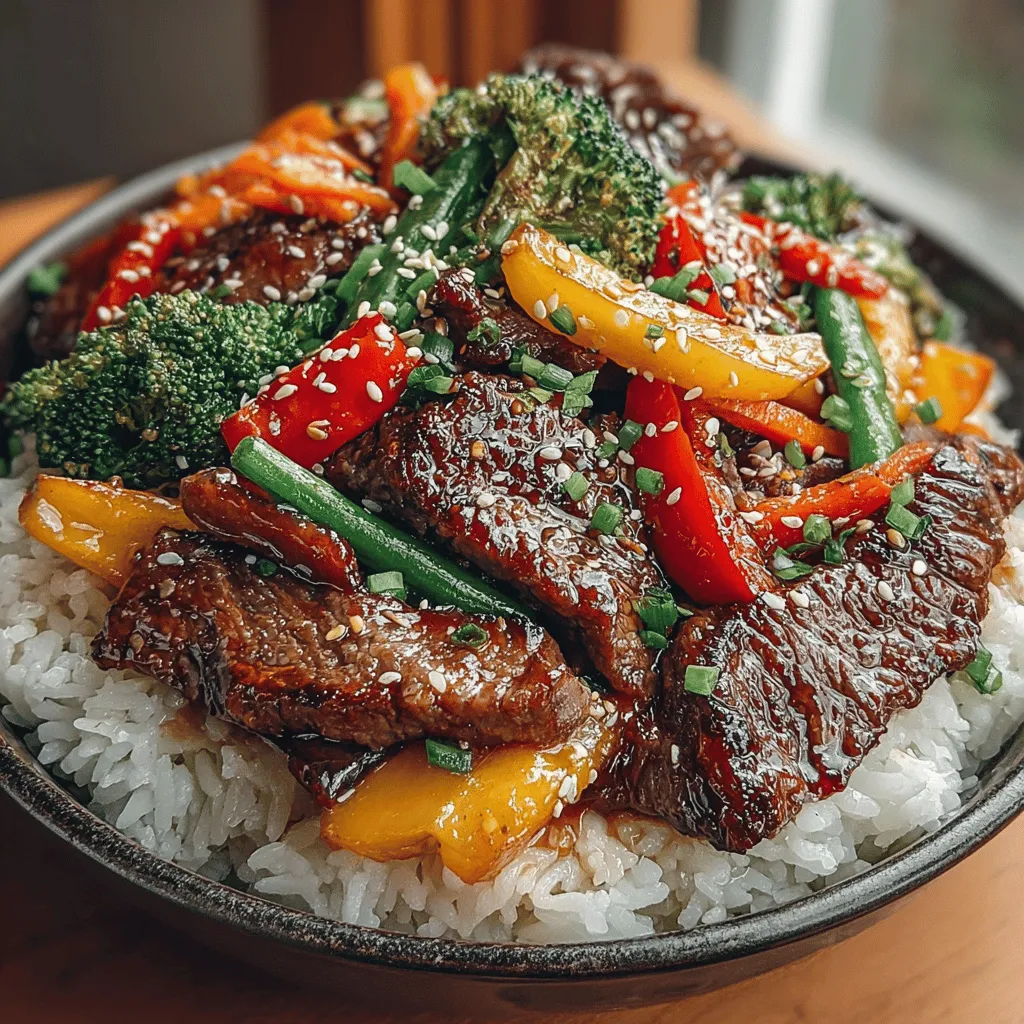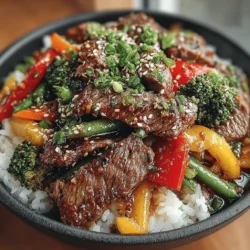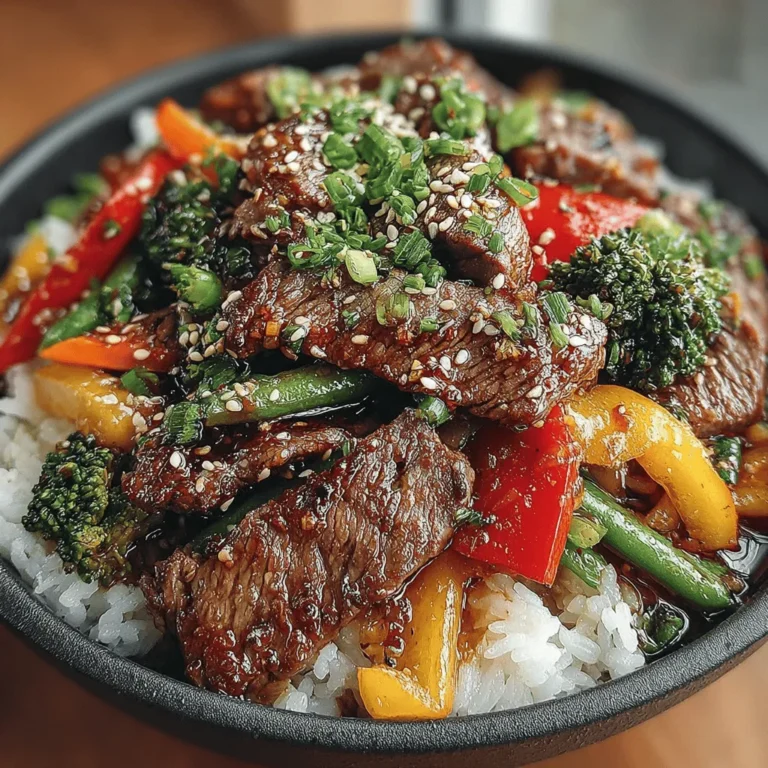Teriyaki Delight: Beef & Veggie Stir-Fry
Introduction
Teriyaki cuisine has captivated taste buds around the globe, thanks to its harmonious blend of flavors and vibrant presentation. Originating from Japan, teriyaki refers to a cooking method that involves grilling or broiling meat and glazing it with a sweet soy sauce mixture. The term itself derives from “teri,” meaning glaze, and “yaki,” which means grilled or broiled. Over the years, teriyaki has evolved beyond its traditional roots, becoming a beloved staple in Asian cooking and a favorite among home cooks seeking quick, flavorful meals.
One standout recipe that embodies the essence of teriyaki is the Teriyaki Delight: Beef & Veggie Stir-Fry. This dish combines tender slices of beef with a colorful array of vegetables, all enveloped in a glossy, homemade teriyaki sauce. Perfect for busy weeknights or a cozy weekend dinner, this stir-fry is not only delicious but also easy to prepare, making it an ideal choice for both novice and experienced chefs.
In addition to its tantalizing taste, Teriyaki Delight is packed with health benefits. The lean protein from sirloin beef supports muscle health and keeps you feeling full, while the vibrant mix of fresh vegetables adds essential vitamins, minerals, and antioxidants to your diet. By incorporating a variety of colors on your plate, you’re not only enhancing the visual appeal of your meal but also boosting its nutritional value.
Understanding Teriyaki Sauce
At the heart of any great teriyaki dish lies the teriyaki sauce itself. Traditionally, teriyaki sauce is a simple yet flavorful blend of soy sauce, mirin (a sweet rice wine), sake, and sugar. This combination creates a perfect balance of sweetness, saltiness, and umami, resulting in a sauce that elevates any protein or vegetable it touches.
The origins of teriyaki sauce can be traced back to the Edo period in Japan, where it was used to enhance grilled fish and meat. Over time, this cooking method gained popularity and evolved, leading to various regional adaptations and interpretations. Today, you’ll find countless variations of teriyaki sauce, from the purely traditional to those with modern twists, incorporating ingredients like sesame oil, garlic, and even fruits for added sweetness.
In this recipe for Teriyaki Delight, we adhere to the core principles of teriyaki sauce while also inviting creativity. The key is maintaining that perfect balance of flavors, which can be adjusted to suit individual preferences. Whether you prefer a sweeter sauce or one with a more pronounced savory kick, understanding the fundamental components of teriyaki will empower you to create a sauce that delights your palate.
Ingredients Breakdown
To create a mouthwatering Teriyaki Delight: Beef & Veggie Stir-Fry, you’ll need a handful of quality ingredients. Here’s a closer look at each component and its role in the dish:
– Sirloin Beef: Choosing lean cuts like sirloin not only enhances the dish’s flavor but also contributes to its health benefits. Sirloin is a rich source of high-quality protein, iron, and B vitamins, making it an excellent choice for a nutritious meal. When selecting beef, look for cuts that are firm and bright red, with minimal marbling for the best results.
– Fresh Vegetables: This stir-fry shines with a colorful assortment of vegetables, including bell peppers, broccoli, carrots, and snap peas. Each of these veggies brings its unique nutritional profile to the table. Bell peppers are rich in vitamin C, broccoli is packed with fiber and antioxidants, carrots provide beta-carotene, and snap peas add a delightful crunch along with vitamins A and K. Together, they create a well-rounded dish that is both visually appealing and healthful.
– Key Sauces and Seasonings: The flavor of the dish hinges on the teriyaki sauce, which includes soy sauce, mirin, and ginger. Soy sauce is a staple in Asian cuisine, adding a depth of flavor and umami. Mirin introduces sweetness and a hint of acidity, while ginger imparts a warming spice that brightens the overall taste. For the best results, use high-quality soy sauce and authentic mirin to ensure your sauce has the right balance of flavors.
– Tips on Selecting Ingredients: When it comes to preparing a stir-fry, the quality of your ingredients can make a significant difference in the final dish. Look for fresh, organic vegetables whenever possible, as they offer superior flavor and nutritional benefits. For the beef, consider purchasing from a reputable butcher or grocery store that prioritizes quality and sustainable farming practices. Fresh ingredients not only enhance the taste but also contribute to a more vibrant and appealing presentation.
Preparation Steps for Teriyaki Delight
Now that we’ve covered the essential ingredients, it’s time to delve into the preparation steps for creating the Teriyaki Delight: Beef & Veggie Stir-Fry. The process is straightforward and designed to help you achieve a delicious result with minimal fuss.
1. Preparing the Teriyaki Sauce: Start by making your teriyaki sauce. In a mixing bowl, combine soy sauce, mirin, and a sweetener of your choice—this could be granulated sugar, honey, or brown sugar. Whisk these ingredients together until the sugar fully dissolves. To enhance the flavor, consider adding minced ginger and a splash of sesame oil. If you prefer a thicker sauce, you can mix a small amount of cornstarch with water and add it to the sauce while cooking. This will create a glossy finish that clings beautifully to the meat and vegetables.
2. Cooking the Beef: To ensure even cooking and a nice sear, it’s important to cook the beef in batches. Start by slicing the sirloin into thin strips against the grain; this will help to tenderize the meat. Heat a tablespoon of oil in a large skillet or wok over medium-high heat. Once the oil is shimmering, add the beef in a single layer, making sure not to overcrowd the pan. Let the beef cook undisturbed for a couple of minutes until it develops a nice brown crust. Flip the slices to cook on the other side, then remove them from the skillet and set aside. Repeat this process until all the beef is cooked, adding more oil if necessary.
3. Sautéing the Vegetables: After cooking the beef, add a bit more oil to the same skillet and toss in the fresh vegetables. Start with the denser ones, like carrots and broccoli, as they take longer to cook. Stir-fry for a few minutes until they begin to soften, then add the bell peppers and snap peas. Continue to cook until the vegetables are vibrant and tender-crisp, ensuring that they retain their nutritional value and crunch.
With the beef and vegetables perfectly cooked, you’re on your way to creating a dish that is not only satisfying but also brimming with flavor. As you progress, the tantalizing aroma of teriyaki will fill your kitchen, promising a delightful meal that is sure to impress your family or guests.
Stay tuned for the next part of the recipe, where we will explore how to bring it all together with the final cooking steps and serving suggestions.

Stir-Frying Vegetables: Techniques for Achieving the Perfect Tender-Crisp Texture
Stir-frying is an art that requires practice and knowledge of timing. To achieve that coveted tender-crisp texture in your vegetables, follow these techniques:
1. Preparation: Before you start cooking, wash and cut your vegetables into uniform sizes. This ensures even cooking. For this dish, consider using bell peppers, broccoli, snap peas, and carrots. Their varied colors and textures not only enhance the dish visually but also contribute to a balanced nutrient profile.
2. High Heat: Stir-frying requires a hot pan, preferably a wok or a large skillet. Preheat your pan until it’s smoking slightly. This high temperature is crucial for sealing in the vegetables’ moisture, giving them that delightful crunch.
3. Oil Selection: Use oils with a high smoke point, such as canola or peanut oil. This allows you to sauté the vegetables without burning the oil, which can impart an unpleasant flavor.
4. Add Vegetables in Batches: If you’re cooking a large quantity, add vegetables in batches rather than all at once. Start with the firmest vegetables like carrots and broccoli, and then gradually add softer ones like bell peppers and snap peas. This staggered approach prevents overcooking.
5. Stir Constantly: Keep the vegetables moving in the pan. This constant motion helps them cook evenly and prevents sticking. Use a spatula to flip and toss the vegetables, making sure they maintain contact with the pan for even browning.
6. Seasoning: Add seasonings, such as salt or garlic, towards the end of cooking to enhance flavors without burning them. This will elevate the taste without compromising the texture.
Timing and Temperature Control During Cooking for Best Results
Timing and temperature control are paramount in stir-frying. Here’s how to master both:
– Prep Everything First: Have your ingredients prepped and measured before you start cooking. Stir-frying is a fast-paced process, and having everything ready will help you maintain control over timing.
– Temperature Management: Adjust the heat as necessary. If vegetables start to brown too quickly, lower the heat slightly. Conversely, if they seem to be steaming rather than sautéing, increase the heat. The goal is to achieve a quick sear while maintaining texture.
– Taste Regularly: As you cook, taste the vegetables. This will help you gauge their doneness and prevent overcooking. Aim for vibrant colors and a slight crunch.
Combining and Serving the Dish
Steps to Combine Beef and Vegetables: Techniques for Even Distribution of Flavors
Once your beef and vegetables are cooked, it’s important to combine them effectively to ensure that every bite is packed with flavor:
1. Return the Beef to the Pan: After cooking the vegetables, push them to the side of the pan and add the beef back into the center. This allows the beef to warm up while the flavors meld together.
2. Add the Sauce: Pour your teriyaki sauce over the beef and vegetables. The sauce should be distributed evenly, so use your spatula to gently fold the ingredients together.
3. Toss Everything Together: With the heat still on, toss the mixture to coat everything in the sauce. This ensures that every piece of beef and every vegetable gets a good coating of flavor.
Thicken the Sauce: Explanation of the Cornstarch Slurry and Its Role in Achieving Desired Sauce Consistency
To create a luscious, thick sauce, you will need a cornstarch slurry:
1. Prepare the Slurry: In a small bowl, mix equal parts cornstarch and cold water (typically 1 tablespoon of each). Stir until smooth.
2. Add to the Stir-Fry: Slowly drizzle the slurry into the pan while continuously stirring. The heat will activate the cornstarch, thickening the sauce almost instantly.
3. Cook for Another Minute: Allow the stir-fry to cook for an additional minute. This gives the sauce time to thicken and coats the beef and vegetables beautifully.
Suggestions for Serving: Ideal Pairings and Enhancing Presentation with Garnishes
For the perfect presentation and flavor pairing, consider the following:
– Serve with Rice or Noodles: A bed of jasmine rice or a side of soba noodles complements the stir-fry beautifully. They act as a canvas for the savory sauce, soaking up all the delicious flavors.
– Garnish for Appeal: Enhance the visual appeal of your dish by garnishing with sesame seeds, sliced green onions, or fresh cilantro. These add not only beauty but also fresh flavor notes that elevate the dish.
– Serving Temperature: Serve your stir-fry immediately while it’s hot and fresh. Stir-fries are best enjoyed right off the stove for optimal texture and flavor.
Nutritional Information
Understanding the nutritional value of your meals is crucial for maintaining a balanced diet. Here’s a breakdown of the nutritional information for Teriyaki Delight: Beef & Veggie Stir-Fry per serving (based on a serving size of approximately 1.5 cups):
– Calories: 350
– Protein: 28 grams
– Fats: 15 grams
– Carbohydrates: 30 grams
– Fiber: 5 grams
Discussion on How This Dish Fits into a Balanced Diet
This stir-fry is not only delicious but also well-balanced. The lean beef provides high-quality protein, while an array of colorful vegetables offers essential vitamins and minerals. The combination of protein, healthy fats, and fiber-rich carbohydrates makes it a satisfying meal that keeps you full and energized.
Comparison to Takeout Options: Healthier Homemade Alternatives
Making Teriyaki Delight at home is a healthier alternative to takeout. Most restaurant versions are high in sodium, sugar, and unhealthy fats. By preparing this dish yourself, you control the ingredients and portion sizes, making it easier to maintain a nutritious diet. You can use low-sodium soy sauce, fresh vegetables, and lean cuts of meat to create a wholesome meal without sacrificing flavor.
Variations and Customizations
Suggestions for Ingredient Substitutions Based on Dietary Preferences
One of the beauties of stir-fry is its versatility. Here are some ways to customize this recipe based on your dietary preferences:
– Alternative Proteins: If you prefer a different protein, chicken or shrimp can be excellent substitutes. For a vegetarian option, use tofu or tempeh, which absorb the flavors of the sauce beautifully.
– Vegetable Swaps: Feel free to swap in your favorite vegetables or seasonal produce. Zucchini, mushrooms, or bok choy can add unique flavors and textures.
Vegan Adaptation: How to Modify the Recipe for a Vegan-Friendly Option
To create a vegan version of Teriyaki Delight, simply omit the beef and use a plant-based protein like tofu or seitan. Ensure your teriyaki sauce is free from animal products, and load up on a variety of vegetables to make it a colorful and nutritious meal.
Conclusion
In conclusion, making Teriyaki Delight: Beef & Veggie Stir-Fry at home is not just a culinary endeavor; it’s an opportunity to enjoy a quick, healthy, and flavorful meal that can easily become a family favorite. With its balance of protein, vegetables, and savory sauce, this dish provides a wholesome meal that pleases the palate.
We encourage you to try this recipe the next time you’re in the mood for a satisfying stir-fry. Cooking at home not only allows for creativity in the kitchen but also brings the joy of sharing delicious, homemade meals with family and friends. Embrace the experience of cooking, and enjoy the delightful flavors of your very own Teriyaki Delight!

